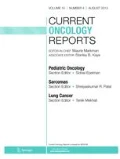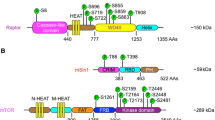Abstract
Current efforts in anticancer drug development are targeting key factors in cell-cycle regulation. Mammalian target of rapamycin (mTOR) is one such protein kinase that facilitates cell growth by stimulating the cell to traverse the G1 to S phase of the cell cycle. Rapamycin is the first defined inhibitor of mTOR, and the demonstration of its antitumor activity has led to great interest in this pathway as an antitumor mechanism. Analogues with better pharmacologic properties have been developed and have entered clinical trials. Human cell lines of renal cell cancer, among several other tumors, are sensitive to growth inhibition via this pathway. Ongoing clinical trials are evaluating renal cell cancer and other malignancies using therapy with mTOR inhibitors. These agents are more likely to induce growth inhibition rather than tumor regression.
Similar content being viewed by others
References and Recommended Reading
Baker H, Sidorowicz A, Sehgal SN, Vezina C: Rapamycin (AY-22,989), a new anti-fungal antibiotic. III. In vitro and in vivo evaluation. J Antibiot (Tokyo) 1978, 31:539–545.
Sehgal SN, Baker H, Vezina C: Rapamycin (AY-22,989), a new anti-fungal antibiotic. II. Fermentation, isolation and characterization. J Antibiot (Tokyo) 1975, 28:727–732.
Vezina C, Kudelski A, Sehgal SN: Rapamycin (AY-22,989), a new antifungal antibiotic. I. Taxonomy of the producing streptomycete and isolation of the active principle. J Antibiot (Tokyo) 1975, 28:721–726.
Wiederrecht GJ, Sabers CJ, Brunn GJ, et al.: Mechanism of action of rapamycin: new insights into the regulation of G1-phase progression in eukaryotic cells. Prog Cell Cycle Res 1995, 1:53–71.
Hidalgo M, Rowinsky EK: The rapamycin-sensitive signal transduction pathway as a target for cancer therapy. Oncogene 2000, 19:6680–6686. This paper provides an excellent summary of the rapamycin-sensitive pathway in signal transduction and describes the biologic effects of inhibiting this pathway.
Neshat M, Mellinghoff I, Tran C, et al.: Enhanced sensitivity of PTEN-deficient tumors to inhibition of FRAP/mTOR. Proc Natl Acad Sci U S A 2001, 98:10314–10319. This paper describes how inhibition or deletion of PTEN, an oncogene, contributes to antitumor sensitivity to mTOR inhibition.
Dudkin L, Dilling MB, Cheshire PJ, et al.: Biochemical correlates of mTOR inhibition by the rapamycin ester CCI-779 and tumor growth inhibition. Clin Cancer Res 2001, 7:1758–1764.
Yu K, Toral-Barza L, Discafani C, et al.: mTOR, a novel target in breast cancer: the effect of CCI-779, an mTOR inhibitor, in preclinical models of breast cancer. Endocr Relat Cancer 2001, 8:249–258.
Shi Y, Gera J, Hu L, et al.: Enhanced sensitivity of multiple myeloma cells containing PTEN mutations to CCI-779. Cancer Res 2002, 62:5027–5034.
Gibbons JJ, Discafani C, Peterson R, et al.: The effect of CCI-779, a novel macrolide antitumor agent, on the growth of human tumor cells in vitro and in nude mouse xenograft in vivo [abstract]. Proc Am Assoc Cancer Res 2000, 40:301.
Turner KJ, Moore JW, Jones A, Taylor CF, et al.: Expression of hypoxia-inducible factors in human renal cancer: relationship to angiogenesis and to the von Hippel-Lindau gene mutation. Cancer Res 2002, 62:2957–2961. This paper describes the relationship of angiogenesis and the von Hippel-Lindau mutation, which contributes to a vascularly stimulated growth pattern.
Ohh M, Park CW, Ivan M, et al.: Ubiquitination of hypoxia-inducible factor requires direct binding to the beta-domain of the von Hippel-Lindau protein. Nat Cell Biol 2000, 2:423–427.
Iliopoulos O, Levy AP, Jiang C, et al.: Negative regulation of hypoxia-inducible genes by the von Hippel-Lindau protein. Proc Natl Acad Sci U S A 1996, 93:10595–10599.
Hudson CC, Liu M, Chiang GG, et al.: Regulation of hypoxia-inducible factor 1-alpha expression and function by the mammalian target of rapamycin. Mol Cell Biol 2002, 22:7004–7014.
Hopfl G, Wenger RH, Ziegler U, et al.: Rescue of hypoxiainducible factor-1alpha-deficient tumor growth by wild-type cells is independent of vascular endothelial growth factor. Cancer Res 2002, 62:2962–2970.
Huang S, Houghton PJ: Targeting mTOR signaling for cancer therapy. Curr Opin Pharmacol 2003, 3:371–377.
Chen Y, Zheng Y, Foster DA: Phospholipase D confers rapamycin resistance in human breast cancer cells. Oncogene 2003, 22:3937–3942.
Geoerger B, Kerr K, Tang C-B, et al.: Antitumor activity of the rapamycin analog CCI-779 in human primitive neuroectodermal tumor/medulloblastoma models as single agent and in combination chemotherapy. Cancer Res 2001, 61:1527–1532.
Raymond E, Alexander J, Depenbrock H, et al.: CCI-779, a ester analog of rapamycin that interacts with PTEN/PI3 kinase pathways: a phase I study utilizing a weekly intravenous schedule [abstract]. Presented at the 11th NCI-EORTC-AACR Symposium on New Drugs in Cancer Therapy. Amsterdam, November 7–10, 2000.
Hidalgo M, Rowinsky E, Erlichman C, et al.: Phase I and pharmacologic study of CCI-779, a cell cycle inhibitor [abstract]. Presented at the 11th NCI-EORTC-AACR Symposium on New Drugs in Cancer Therapy. Amsterdam, November 7–10, 2000.
Atkins MB, Hidalgo M, Stadler W, et al.: A randomized doubleblind phase 2 study of intravenous CCI-779 administered weekly to patients with advanced renal cell carcinoma [abstract]. Proc ASCO 2002, 21:36. CCI-779 induces prolonged stable disease in patients with renal cell carcinoma. Long term follow-up is pending.
Dutcher JP, Hudes G, Motzer R, et al.: Preliminary report of a phase I study of intravenous CCI-779 given in combination with interferon-alpha in patients with advanced renal cell carcinoma [abstract]. Proc ASCO 2003, 22:213.
Chan S, Scheulen ME, Johnston S, et al.: Phase 2 study of two dose levels of CCI-779 in locally advanced or metastatic breast cancer failing prior anthracycline and/or taxane regimens [abstract]. Proc ASCO 2003, 22:193. Prolonged disease-free survival is noted in this study. Long-term follow-up is pending.
Buckner J, Prados M, Rowinsky E, et al.: A phase I study of the safety, tolerability and pharmacokinetics of intravenous CCI-779 given once daily for 5 days every 2 weeks in patients with CNS tumors. Presented at the 8th annual meeting of the Society for Neuro-Oncology. San Diego, CA, November 2002.
O’Donnell M, Faivre I, Judson C, et al.: A phase I study of the oral mTOR inhibitor RAD001 as monotherapy to identify the optimal biologically effective dose using toxicity, pharmacokinetic and pharmacodynamic endpoints in patients wit solid tumors [abstract]. Proc ASCO 2003, 22:200.
Clackson T, Metcalf CCA, Rivera VM, et al.: Broad anti-tumor activity of ap23573, an mTOR inhibitor in clinical development [abstract]. Proc ASCO 2003, 22:220.
Author information
Authors and Affiliations
Rights and permissions
About this article
Cite this article
Dutcher, J.P. Mammalian target of rapamycin (mTOR) inhibitors. Curr Oncol Rep 6, 111–115 (2004). https://doi.org/10.1007/s11912-004-0022-5
Published:
Issue Date:
DOI: https://doi.org/10.1007/s11912-004-0022-5




